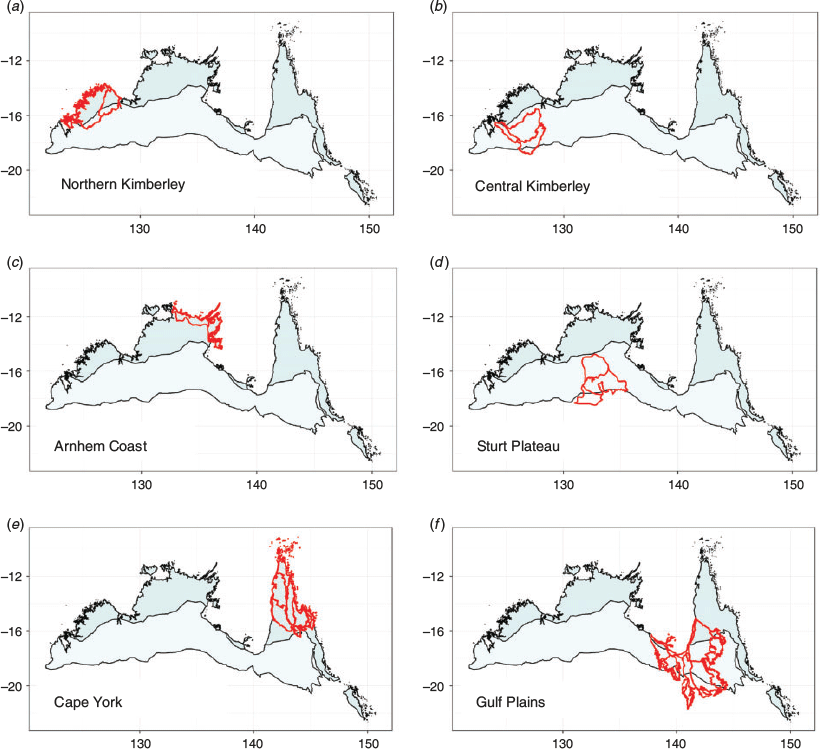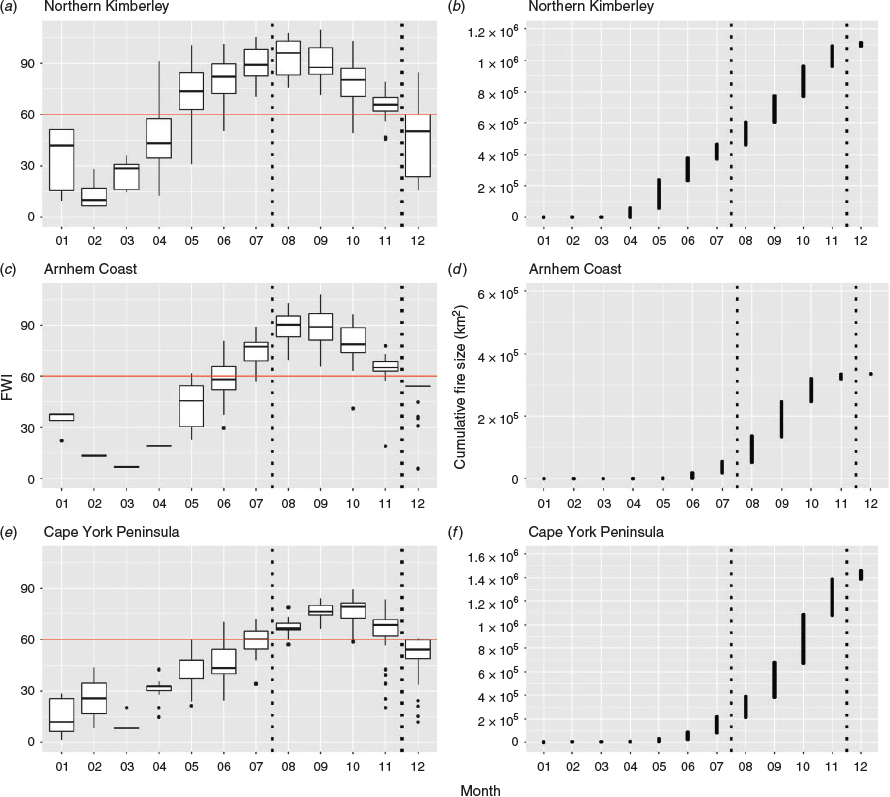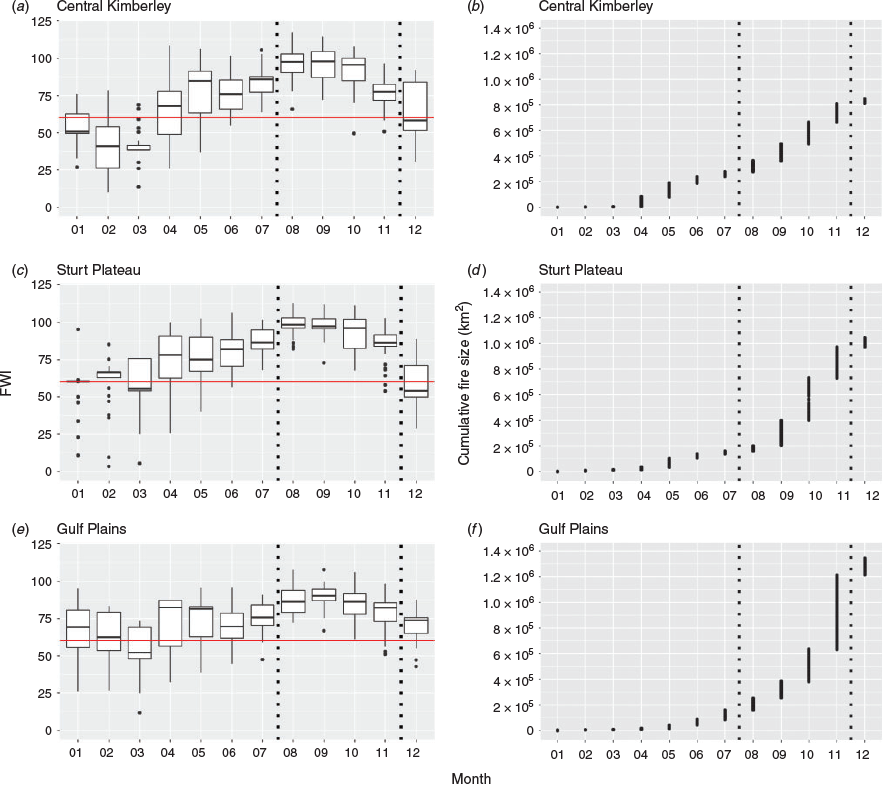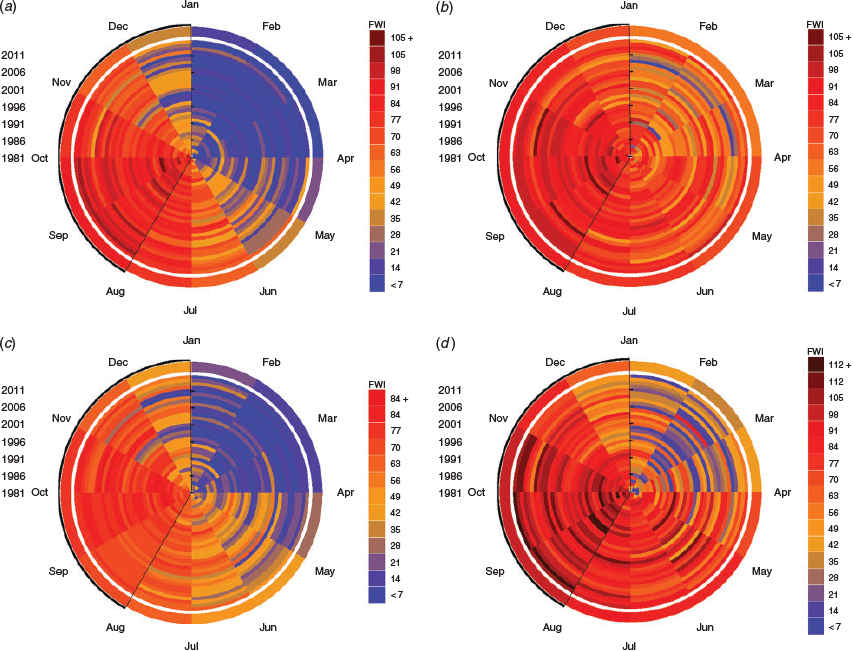Regional seasonality of fire size and fire weather conditions across Australia’s northern savanna
Justin J. Perry A E , Garry D. Cook B , Erin Graham C , C. P. (Mick) Meyer B , Helen T. Murphy D and Jeremy VanDerWal CA CSIRO, PMB PO Aitkenvale, Qld 4814, Australia.
B CSIRO, PMB 44, Winnellie, NT 0822, Australia.
C Centre for Tropical Biodiversity and Climate Change, James Cook University, Townsville, Qld 4811, Australia.
D CSIRO, PO Box 780, Atherton, Qld 4883, Australia.
E Corresponding author. Email: justin.perry@csiro.au
International Journal of Wildland Fire 29(1) 1-10 https://doi.org/10.1071/WF19031
Submitted: 10 March 2019 Accepted: 23 September 2019 Published: 31 October 2019
Journal Compilation © IAWF 2020 Open Access CC BY-NC-ND
Abstract
Australia’s northern savannas have among the highest fire frequencies in the world. The climate is monsoonal, with a long, dry season of up to 9 months, during which most fires occur. The Australian Government’s Emissions Reduction Fund allows land managers to generate carbon credits by abating the direct emissions of CO2 equivalent gases via prescribed burning that shifts the fire regime from predominantly large, high-intensity late dry season fires to a more benign, early dry season fire regime. However, the Australian savannas are vast and there is significant variation in weather conditions and seasonality, which is likely to result in spatial and temporal variations in the commencement and length of late dry season conditions. Here, we assess the temporal and spatial consistency of the commencement of late dry season conditions, defined as those months that maximise fire size and where the most extreme fire weather conditions exist. The results demonstrate that significant yearly, seasonal and spatial variations in fire size and fire weather conditions exist, both within and between bioregions. The effective start of late dry season conditions, as defined by those months that maximise fire size and where the most extreme fire weather variables exist, is variable across the savannas.
Additional keywords: burning, carbon farming, fire management.
Introduction
The savannas of northern Australia cover over 2 million km2 and have very low human population density, limited infrastructure and relatively intact natural ecosystems (Woinarski et al. 2007). This region has a monsoonal climate, with an intense wet season followed by a long, warm dry season of 6–9 months that is typically rain-free and highly fire-prone (Cook and Heerdegen 2001). Fire frequency across the Australian savannas is among the highest in the world (Andersen et al. 2005; Russell-Smith et al. 2007).
Much of the scientific literature considers fire behaviour in northern Australia to be qualitatively different in the early dry season compared with the late dry season (Andersen et al. 1998; Russell-Smith et al. 2007). Breaking fire behaviour into temporal classes (namely, early dry season (EDS) and late dry season (LDS)) facilitates accounting of smoke emissions, including greenhouse gases, and has become embedded into the scientific thinking. This can be seen in the national greenhouse gas (GHG) accounting methodologies in the National Inventory Report (National Greenhouse Gas Inventory Committee 2007; Meyer et al. 2015). Cook et al. (1995) argued that ‘maintaining a regime of frequent but low intensity and patchy fires is probably the best practical way to minimise the release of undesirable trace gases’ and showed that the release of GHG from individual fires was substantially higher in late rather than in early dry season fires (Cook 2003). With further development (Russell-Smith et al. 2003; Russell-Smith et al. 2009a), this approach was successfully piloted in the Western Arnhem Land Fire Abatement project (Fig. 1) (Russell-Smith et al. 2013) and led to the development of GHG mitigation methodologies (Commonwealth of Australia 2012, 2015, 2018) that are now being applied and advocated across northern Australia’s savannas. These methodologies are part of Australia’s emissions reduction strategy and provide tradable carbon credits.
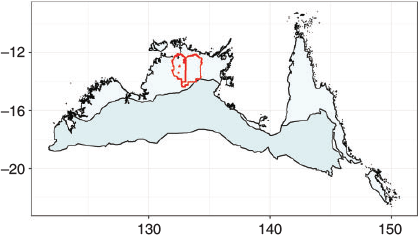
|
The bulk of the research underpinning the methodologies was conducted in Kakadu National Park (Hurst et al. 1994; Cook 2003) and the adjoining Western Arnhem Land (Fig. 1) (Russell-Smith and Edwards 2006; Russell-Smith et al. 2009b). Although additional fuel load and emissions measurements have been undertaken across northern Australia (Meyer et al. 2015; Yates et al. 2015), there has been no explicit testing of the assumption that the categorisation of fires into either low-intensity early or high-intensity late classes applies in all years across this region or of the assumption that a consistent date distinguishing the two categories applies across the whole region. Currently, the 2015 Emissions Reduction Fund (ERF) Savanna Fire Management Determination defines the EDS as ending on 31 July and the LDS starting on 1 August and ending on 31 December across the entire eligible area of the Australian tropical savanna.
To address the question of whether two classes of fires are adequate, we need to examine spatial and temporal variations in both the drivers of fire behaviour and the measurable statistics describing fire occurrence. Fire characteristics change through the dry season. These changes include the drivers of fire behaviour (e.g. the severity of fire weather, fuel curing and fuel load), the properties of fires (e.g. the rate of fire spread, Byram fire line intensity, fire radiative power) and the combustion processes (e.g. fuel burning efficiency). Fire size and fire patchiness are emergent properties from the combined effects of these characteristics. Most fire characteristics have not been measured at the subcontinental and multi-year scales required for an exploration of the spatial and temporal variations in fires across northern Australia. However, two datasets are available at appropriate scales to address this question: the Canadian Fire Weather Index (FWI) (Field et al. 2015) and the 30-year Landgate fire area product. The FWI provides an index of potential fire weather and the Landgate data provide a measure of realised fire activity.
Where a landscape is continuously vegetated and not dissected by human activity, fires should be limited by fire weather rather than by artificial landscape barriers. Northern Australia, with its extremely low human population density for the tropical savanna biome (Woinarski and Dawson 2002), is an ideal location to examine the relationship between fire weather and fire size. In this study we assessed seasonal changes in fire weather indices and fire size across six northern Australian (Interim Biogeographic Regionalisation of Australia: IBRA) bioregions over the past 28 years. We examined the spatial and temporal patterns of fire activity in the EDS and LDS across the low rainfall zone (600–1000 mm annual rainfall) and the high rainfall zone (>1000 mm) covered by the 2015 ERF Savanna Fire Management Determination.
Methods
We present a comparison of six representative bioregions that reflect the variation in weather across the study area and the associated variation in the relationship between the FWI and fire size (Fig. 2): three from the high rainfall zone (>1000 mm mean annual rainfall) in Western Australia (Northern Kimberly), the Northern Territory (Arnhem Coast) and Queensland (Cape York Peninsula) and three from the low rainfall zone (600–1000 mm mean annual rainfall) in Western Australia (Central Kimberly), the Northern Territory (Sturt Plateau) and Queensland (Gulf Plains).
Seasonal changes in fire size
The longest continuous time series of fire activity in Australia is produced by Landgate (www.landgate.wa.gov.au, accessed 16 February 2017). The time series extends from January 1988 to the present, at a time resolution of 1 month and a spatial resolution of 1 km2. The product is derived from the National Oceanic and Atmospheric Administration's Advanced Very High-Resolution Radiometer (NOAA AVHRR) imagery and fire scars are identified from reflectance changes between successive 10-day image pairs. This is the dataset that provides the activity data for Australia’s National Inventory Reports to the United Nations Framework Convention on Climate Change.
Fire-affected areas are defined as fire scar polygons. Landgate-derived fire scars provide the spatial location of the fire-affected area, which month the fire occurred in and the size of the fire scar in that month. Landgate monthly fire scar vector files (shapefiles) were intersected with the polygons defining the Interim Biogeographic Regionalisation for Australia (IBRA) bioregions. After removing artefact sliver polygons less than 100 ha in area, the monthly shapefiles were merged into a continuous time series from 1988 to 2015. The attribute table was then combined by a spatial join with that of the vegetation layer used in the National Inventory Report and the ERF tool, SAVBAT 2, to identify all fire polygons falling partly or completely within the savanna woodland region of northern Australia as defined in the 2015 ERF methodology (Commonwealth of Australia 2015).
Fire size accumulation plots were derived for representative high and low rainfall bioregions by adding total burnt area (km2: 1988–2015) for each month and bioregion. Using this method, the length of the line in each month illustrated the quantum of area burnt in all years, reflecting both the number of fires and the area burnt. Bioregions that follow the seasonal patterns prescribed in the savanna burning methodology (2015) displayed the largest accumulation of fire area (longest lines) between August and December.
Fire Weather Index
The Canadian FWI has been derived globally, based on formulae set out by Van Wagner (1987). The FWI is particularly pertinent for this study because it is derived using variables that aim to represent the peak daily intensity of a fire and reflects the energy output rate per unit length of fire front. Therefore, if a strong relationship exists between fire size (i.e. reflecting realised fire spread) and increasing FWI, then the higher FWI value should also reflect increased intensity, which in turn has been directly correlated with decreased patchiness (Dowdy et al. 2009). A linear regression was used to assess the relationship between mean monthly FWI and mean fire size for each bioregion. We expected weaker relationships between fire weather and fire size in areas with the higher interannual variation. We averaged our FWI and fire size values for each month over 28 years because this best reflects the methods used to define the high and low rainfall regions in the savanna burning methodology.
We also present a summary of the linear models for each of the 28 years to demonstrate the influence of interannual variation in weather and report the mean, median and standard deviation of the R2 values across the 28 years. In low average annual rainfall regions we expected to record high interannual variation in rainfall, which will influence fuel accumulation and fuel connectivity. Regions that exhibit consistent annual rainfall seasonality are likely to have consistently stronger relationships between fire weather and fire size and higher median R2 values. We quantified the consistency of the strength of the linear relationship by reporting the number of years (n = 28) where R2 exceeded 0.5. We also present a polar plot illustrating monthly FWI values for each year to reflect the interannual variation in seasonal fire weather between representative high and low rainfall bioregions.
The FWI is derived using variables that relate to fire spread and fuel availability and combustibility. In simple terms, FWI = initial spread index (ISI) + buildup index (BUI). Weather variables used to estimate ISI and BUI are presented in Fig. 3. Global FWI values at a 0.5 degree resolution were downloaded from the global fire weather database (https://data.giss.nasa.gov/impacts/gfwed/, accessed 18 May 2016) and clipped to the Australian continent. The values were then intersected with the 1-km standard grid used to extract other values in the study area. To summarise FWI at the regional and subregional scale, changes in FWI were extracted for each representative high and low rainfall regions and presented in polar plots (Whickam 2009) derived in R (R Development Core Team 2014). The FWI data used in these analyses were derived from daily data by extracting the 70th percentile of FWI for each month in each region and sub-region using the quantile function in R (R Development Core Team 2014).
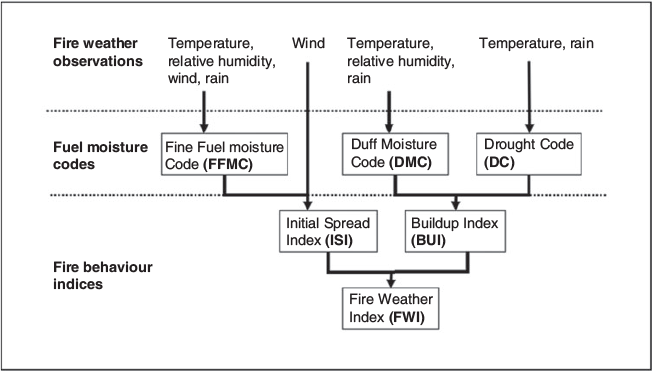
|
In Australia the McArthur Forest Fire Danger Index (FFDI) (McArthur 1967) is widely used to forecast the influence of weather on fire behaviour and the Australian Bureau of Meteorology issues forecasts of the Grassland and Forest Fire Danger Index (GFDI and FFDI) for use by fire authorities. The FFDI and GFDI have an associated set of classification thresholds ranging from low to extreme, as shown in Table 1. Dowdy et al. (2009) describes implementation of the FWI system over Australia using gridded numerical weather prediction model fields and an 8-year dataset of daily values. The FWI fields are compared with an equivalent set of FFDI fields (calculated from the same set of meteorological inputs). Classification thresholds of the FWI were calculated based on those of the FFDI by matching percentiles of the FWI to percentiles of FFDI throughout Australia. Thus, FWI values over 64 are approximately equivalent to a very high fire danger rating. In this study we assessed the month in which the median 70th percentile of FWI values exceeded this level.

|
Results
Seasonal variation in fire size and FWI in the high rainfall zone (>1000 mm year−1)
When aggregating to region, across years, there was a strong relationship between the size of the largest fires (70th percentile) and the mean monthly FWI (70th percentile) for bioregions in the high rainfall zone (Figs 4, 5).
The cumulative fire size increased roughly linearly between May and October in the Northern Kimberly bioregion (Fig. 4b). There was a linear relationship between FWI and fire size in the Northern Kimberley (R2 = 0.8) (Fig. 6b). The relationship between fire weather and fire size was relatively consistent across 28 years, with 20 years above R2 of 0.5 and a median R2 value of 0.61 (Table 2). The FWI was consistently greater than 60 between May and November (Fig. 4a).
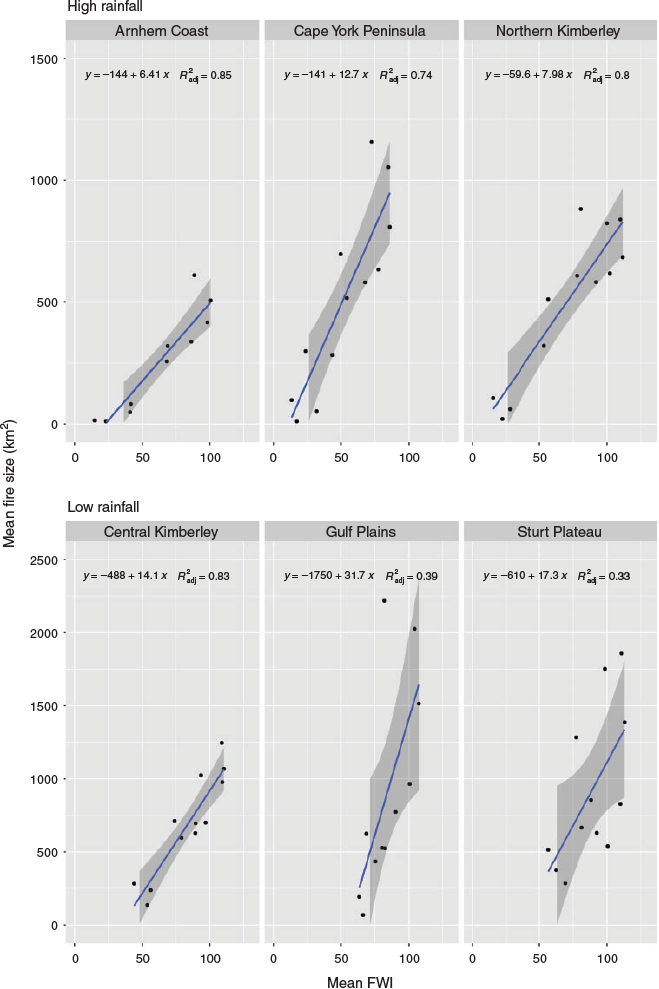
|
For the Arnhem Coast bioregion, the 70th percentile of FWI for all months and fire sizes (70th percentile) were strongly related (R2 = 0.85) (Fig. 6a). The regression also illustrates that fire size was maximised above a FWI value of 75. The FWI was consistently higher between August and October (Fig. 4c), with the largest fires occurring between July and October (Fig. 4d). Seasonality was very consistent across time, with 25 of the 28 years exhibiting a strong relationship between fire size and fire weather (median R2 of 0.72) (Table 2).
For the Cape York Peninsula bioregion there was a similar linear relationship to Arnhem Coast but not as strong (R2 = 0.74) (Fig. 6b) and less consistent, with 19 of the 28 years above 0.5 and a lower median R2 value of 0.58 (Table 2). The FWI was consistently high (>60) between August and November (Fig. 4e). The largest fires were observed between July and November, with the greatest accumulation occurring from September to November (Fig. 4f).
Seasonal variation in the low rainfall zone (600–1000 mm year−1)
The seasonality in the low rainfall zone was less consistent than in the high rainfall zone. For all three bioregions, the FWI regularly exceeded the very high fire danger threshold in April and continued through to December (Fig. 5a, c, e).
The Central Kimberly bioregion demonstrated a relatively strong relationship between fire size and FWI (R2 = 0.83) (Fig. 6d) and displayed a similar relationship to the adjacent high rainfall Northern Kimberly where FWI >40 predicted larger fires but did not express a linear relationship beyond FWI of ~60 (Fig. 6d). However, the relationship was weak when considering interannual variation with a much lower median R2 of 0.43, high standard deviation (0.23) and only 10 of the 28 years above R2 0.5 (Table 2). Fire accumulation was similar between April and November, with a reduction in fire-affected areas in June and July (Fig. 5b). The FWI remained high across the year and was mostly >60 between April and November (Fig. 5a).
The Sturt Plateau showed a very weak relationship between FWI and mean fire size (R2 = 0.33) (Fig. 6f), which was consistently low across the 28-year period (median R2 of 0.19) and highly variable (standard deviation 0.18) (Table 2). Only 2 of the 28 years exceeded an R2 of 0.5 (Table 2). In this region FWI values below 50 restricted fire size and values above 80 maximised fire size, but between FWI 60 and 100 the residuals were very large (Fig. 6f). Slightly larger fires were observed between May and August, but the majority of large fires occurred between September and November (Fig. 5d). The FWI remained greater then 60 for the entire year except for December (Fig. 5c).
The Gulf Plains bioregion had a weak linear relationship between FWI and fire size (R2 = 0.39) (Fig. 6e) and a low median R2, 0.21, with a relatively high standard deviation (0.15) (Table 2). A relatively strong relationship between FWI and fire size was only recorded once in 28 years (Table 2). The FWI remained high (>60) for the entire year with an increasing fire-affected area evident from July to November (peaking in November, Fig. 5e, f).
Temporal variation in the FWI
The Arnhem Coast bioregion demonstrated the most consistent seasonal pattern, with a distinct and dependable wet season followed by a gradual increase in FWI from April, leading to extreme fire weather between August and November, decreasing again in December (Fig. 7a). Cape York Peninsula followed a similar pattern; however, the FWI was more extreme in September (Fig. 7c). In contrast, the FWI in the low rainfall zones was far less consistent across years, remaining high throughout the nominal wet season period (January–March) (Fig. 7). The FWI and fire size had a strong relationship in the Central Kimberly bioregion and this region demonstrated a far more consistent seasonal pattern of low FWI between January and March (Fig. 7d) when compared with the Gulf Plains, which did not have a consistent wet season across years (Fig. 7b).
Discussion
We present an analysis of seasonality based on the fire weather conditions that support large fires. The results demonstrated that significant seasonal variation in fire size and fire weather exists both within and between rainfall zones, and within and between bioregions. In particular, the seasonality in both the FWI and fire size in the low rainfall zone was less consistent than in the high rainfall zone. In addition, the very high fire danger period occurred over a longer period in the low rainfall zone (April–December) compared with the high rainfall zone.
The strongest relationship between FWI and fire size was observed in the Arnhem Coast bioregion where the annual variance in FWI was also relatively consistent in the LDS. In this bioregion, the largest fires and highest FWI occurred between July and October. The Cape York Peninsula bioregion is large and diverse and includes rainforest-dominated regions supporting higher than average annual rainfall and lower than average temperatures, which influences the mean when aggregating results in this region. Median September FWI in the Cape York Peninsula was roughly equivalent to the Arnhem Coast July level, reflecting a 2-month difference in peak fire weather conditions. The largest fires occurred consistently in November – 1 month later than in the Arnhem Coast bioregion.
The relationship between FWI and fire size in the Northern Kimberly was slightly weaker than in the Cape York Peninsula and the Arnhem Coast and the fire season started abruptly in April–May in most years. The difference between the EDS and LDS was minimal, with the data indicating that large fires occurred across most of the year. In the low rainfall zone, the Central Kimberly bioregion is adjacent to the high rainfall Northern Kimberly bioregion and showed a similar pattern in fire seasonality with a relatively early start to the fire season. In the Central Kimberley, the relationship between FWI and fire size was high, which is anomalous for the low rainfall bioregion. This is likely to be related to the prevalence of cyclone-driven rain events that are common in this region (Charles et al. 2015), evidenced in this study through consistently low FWI values during the wet season months.
The poor relationship between the FWI and fire size in the Sturt Plateau suggested that this bioregion does not demonstrate strong seasonal changes in fire size across time. Similarly, although the relationship was stronger in the Gulf Plains, the distinction between the wet season, EDS and LDS was less clear than in the high rainfall zone.
The results demonstrated that the effective start of LDS conditions, as defined by those months that maximise fire size and where the most extreme fire weather variables exist, varied across the savannas depending on the annual consistency of fire weather indices. This has implications for the adequacy of carbon accounting and a potential effect on biodiversity conservation where fire management activities are based on the EDS and LDS definitions in the methodology rather than the realised regional seasonality.
We used fire size as a proxy for fire intensity and uniformity on the assumption that larger fires indicate a more connected landscape and more complete combustion. For a fire to leave unburnt patches the fire has to be extinguished. This could happen because the fuel load is uneven and too low in some patches for the vegetation to support a fire. If fuels are discontinuous, such as in a spinifex grassland, gaps between fuel patches might be too large for the fire to preheat adjacent unburnt fuels to ignition (Cheney and Sullivan 1997). Extinction of the fire in patches could also occur if fuel moisture or grass curing is patchy, because fuel moisture is one of the factors determining rate of heat release. It is particularly important in grasslands where senescence and curing are a feature of grass phenology; when fuel moisture content values exceed ~20% of fuel dry weight, combustion is unsustainable and fires are unlikely to spread (Cheney et al. 1998). This occurs when grass swards are less than 50% cured; where fuel characteristics are non-uniform, patches of uncured grass or moist fuel lead to unburnt patches.
Heterogeneity of grass curing (and hence fuel moisture) also leads to decreases in the maximum rate of fire spread (Hilton 2015), as slower moving fires are more likely to extinguish and patchy fires tend to be small fires. Uniform fires, by contrast, can continue to expand for long periods and leave large scars. Hence fire size should be an indicator of fire intensity and a seasonal progression of mean fire size might be a useful indicator of the seasonal transition in fire behaviour. Under these assumptions, the LDS, as defined in the carbon abatement methodology, is not consistent across bioregions and particularly between the low and high rainfall zones. However, validation of these assumptions will require field testing of the relationships between fire size, intensity and patchiness across the climatic and edaphic variance in the study area.
Conclusions
The savanna-wide characterisation of low-intensity early and high-intensity late dry season fires is ambiguous. The characterisation is clearer in the higher-rainfall bioregions of the savannas where temporal and spatial seasonal variability between years is low. Lower rainfall areas exhibit weaker seasonal patterns in fire size and fire weather and higher spatial and temporal variability. The temporal and spatial variations in the commencement and length of LDS conditions within and between the six bioregions presented here and at a subregional level (https://publications.csiro.au/rpr/pub?list=SEA&pid=csiro:EP186538, accessed 1 July 2019) suggests that the step change in burning efficiency and patchiness assumed by the ERF methodology between the EDS and LDS and between the high and low rainfall zones, requires further assessment to provide a more realistic approach to assessing changes in emissions.
Conflicts of interest
The authors declare no conflicts of interest.
Acknowledgements
This research was funded by the Australian Government, Department of the Environment and Energy, through the Emissions Reduction Fund. Allan Spessa provided value feedback in the early stages of this study that helped to refine the analytical pathway.
References
Andersen AN, Braithwaite RW, Cook GD, Corbett LK, Williams RJ, Douglas MM, Gill AM, Setterfield SA, Muller WJ (1998) Fire research for conservation management in tropical savannas: introducing the Kapalga fire experiment. Australian Journal of Ecology 23, 95–110.| Fire research for conservation management in tropical savannas: introducing the Kapalga fire experiment.Crossref | GoogleScholarGoogle Scholar |
Andersen AN, Cook GD, Corbett LK, Douglas MM, Eager RW, Russell-Smith J, Setterfield SA, Williams RJ, Woinarski JCZ (2005) Fire frequency and biodiversity conservation in Australian tropical savannas: implications from the Kapalga fire experiment. Austral Ecology 30, 155–167.
| Fire frequency and biodiversity conservation in Australian tropical savannas: implications from the Kapalga fire experiment.Crossref | GoogleScholarGoogle Scholar |
Charles S, Fu G, McFarlane D, Hodgson G, Teng J, Barron O, Aryal S, Dawes W (2015) Hydroclimate of the Pilbara: past, present and future. A report to the Government of Western Australia and industry partners from the CSIRO Pilbara Water Resource Assessment. CSIRO Land and Water, Australia. Available at https://publications.csiro.au/rpr/download?pid=csiro:EP157752&dsid=DS2 [Verified 10 October 2019].
Cheney P, Sullivan A (1997) ‘Grassfires: fuel, weather and fire behaviour.’ (CSIRO Publishing: Melbourne)
Cheney N, Gould J, Catchpole W (1998) Prediction of fire spread in grasslands. International Journal of Wildland Fire 8, 1–13.
| Prediction of fire spread in grasslands.Crossref | GoogleScholarGoogle Scholar |
Commonwealth of Australia. (2012) Carbon Farming (Reduction of Greenhouse Gas Emissions through Early Dry Season Savanna Burning) Methodology Determination 2012. Federal Register of Legislative Instruments F2012L01499: 37. Commonwealth of Australia, Canberra.
Commonwealth of Australia (2015) Carbon Credits (Carbon Farming Initiative—Emissions Abatement through Savanna Fire Management) Methodology Determination 2015. Federal Register of Legislative Instruments F2015L00344: 40. Commonwealth of Australia, Canberra.
Commonwealth of Australia (2018) Carbon Credits (Carbon Farming Initiative—Savanna Fire Management—Sequestration and Emissions Avoidance) Methodology Determination 2018. Authorised Version F2018L00562: 47. Commonwealth of Australia, Canberra.
Cook GD (2003) Fuel dynamics, nutrients and atmospheric chemistry. In ‘Fire in tropical savannas.’ (Eds AN Andersen, GD Cook, RJ Williams) pp. 47–58. (Springer: New York)
Cook GD, Heerdegen RG (2001) Spatial variation in the duration of the rainy season in monsoonal Australia. International Journal of Climatology 21, 1723–1732.
| Spatial variation in the duration of the rainy season in monsoonal Australia.Crossref | GoogleScholarGoogle Scholar |
Cook GD, Hurst D, Griffith D (1995) Atmospheric trace gas emissions from tropical Australian savanna fires. CALMscience 4, 123–128.
Dowdy AJ, Mills GA, Finkele K, De Groot WJ (2009) Australian fire weather as represented by the McArthur Forest Fire Danger Index and the Canadian Forest Fire Weather. CAWCR Technical Report 10. The Centre for Australian Weather and Climate Research, Melbourne, Australia. Available at www.cawcr.gov.au/technical-reports/CTR_010.pdf [Verified 24 February 2017]
Field RD, Spessa AC, Aziz NA, Camia A, Cantin A, Carr R, de Groot WJ, Dowdy AJ, Flannigan MD, Manomaiphiboon K, Pappenberger F, Tanpipat V, Wang X (2015) Development of a global fire weather database. Natural Hazards and Earth System Sciences 15, 1407–1423.
| Development of a global fire weather database.Crossref | GoogleScholarGoogle Scholar |
Hilton JE (2015) Effects of spatial and temporal variation in environmental conditions on simulation of wildfire spread. Environmental Modelling and Software 67, 118–127.
| Effects of spatial and temporal variation in environmental conditions on simulation of wildfire spread.Crossref | GoogleScholarGoogle Scholar |
Hurst DF, Griffith DWT, Cook GD (1994) Trace gas emissions from biomass burning in tropical Australian savannas. Journal of Geophysical Research 99, 16441–16456.
| Trace gas emissions from biomass burning in tropical Australian savannas.Crossref | GoogleScholarGoogle Scholar |
McArthur AG (1967) ‘Fire behaviour in eucalypt forests.’ (Forestry and Timber Bureau: Canberra)
Meyer CPM, Cook GD, Powell J (2015) Australia’s National Greenhouse Gas Inventory 2013: Agriculture. Final Report to the Department of the Environment. (CSIRO Oceans and Atmosphere: Aspendale)
National Greenhouse Gas Inventory Committee (2007) ‘Australian methodology for the estimation of greenhouse gas emissions and sinks 2006: Agriculture.’ (Department of Climate Change: Canberra)
R Development Core Team (2014) ‘R: a language and environment for statistical computing.’ (R Foundation for Statistical Computing: Vienna, Austria) Available at http://www.R-project.org/ [Verified 20 July 2019]
Russell-Smith J, Edwards AC (2006) Seasonality and fire severity in savanna landscapes of monsoonal northern Australia. International Journal of Wildland Fire 15, 541–550.
| Seasonality and fire severity in savanna landscapes of monsoonal northern Australia.Crossref | GoogleScholarGoogle Scholar |
Russell-Smith J, Edwards AC, Cook GD (2003) Reliability of biomass burning estimates from savanna fires: biomass burning in northern Australia during the 1999 Biomass Burning and Lightning Experiment B field campaign. Journal of Geophysical Research 108, 1–12.
| Reliability of biomass burning estimates from savanna fires: biomass burning in northern Australia during the 1999 Biomass Burning and Lightning Experiment B field campaign.Crossref | GoogleScholarGoogle Scholar |
Russell-Smith J, Yates CP, Whitehead PJ, Smith R, Craig R, Allan GE, Thackway R, Frakes I, Cridland S, Meyer MCP, Gill AM (2007) Bushfires ‘down under’: patterns and implications of contemporary Australian landscape burning. International Journal of Wildland Fire 16, 361–377.
| Bushfires ‘down under’: patterns and implications of contemporary Australian landscape burning.Crossref | GoogleScholarGoogle Scholar |
Russell-Smith J, Murphy BP, Meyer MCP, Cook GD, Maier S, Edwards AC, Schatz J, Brocklehurst P (2009a) Improving estimates of savanna burning emissions for greenhouse accounting in northern Australia: limitations, challenges, applications. International Journal of Wildland Fire 18, 1–18.
| Improving estimates of savanna burning emissions for greenhouse accounting in northern Australia: limitations, challenges, applications.Crossref | GoogleScholarGoogle Scholar |
Russell-Smith J, Whitehead P, Cooke P (2009b) ‘Culture, ecology and economy of fire management in north Australian savannas, rekindling the Wurrk tradition.) (CSIRO Publishing: Melbourne)
Russell-Smith J, Cook GD, Cooke PM, Edwards AC, Lendrum M, Meyer CP, Whitehead PJ (2013) Managing fire regimes in north Australian savannas: applying Aboriginal approaches to contemporary global problems. Frontiers in Ecology and the Environment 11, e55–e63.
| Managing fire regimes in north Australian savannas: applying Aboriginal approaches to contemporary global problems.Crossref | GoogleScholarGoogle Scholar |
Van Wagner CE (1987) ‘Development and structure of the Canadian Forest Fire Weather Index System.’ (Canadian Forestry Service, Ottawa)
Whickam H (2009) ‘ggplot2: elegant graphics for data analysis.’ (Springer-Verlag: New York)
Woinarski JCZ, Dawson F (2002) Limitless lands and limited knowledge: coping with uncertainty and ignorance in northern Australia. In ‘Ecology, Uncertainty and Policy: managing ecosystems for sustainability.’ (Eds JW Handmer, TW Norton, SR Dovers) pp. 83–115. (Prentice-Hall: Harlow)
Woinarski J, Mackey B, Nix H, Traill B (2007) ‘The nature of Northern Australia: natural values, ecological processes and future prospects.’ (ANU E Press: Canberra)
Yates C, Russell-Smith J, Murphy BP, Desailly M, Evans J, Legge S, Lewis F, Lynch D, Edwards AC (2015) Fuel accumulation, consumption and fire patchiness in the lower rainfall savanna region. In ‘Carbon accounting and savanna fire management.’ (Eds BP Murphy, AC Edwards, M Meyer, J Russell-Smith) pp. 115–132. (CSIRO Publishing: Melbourne)


